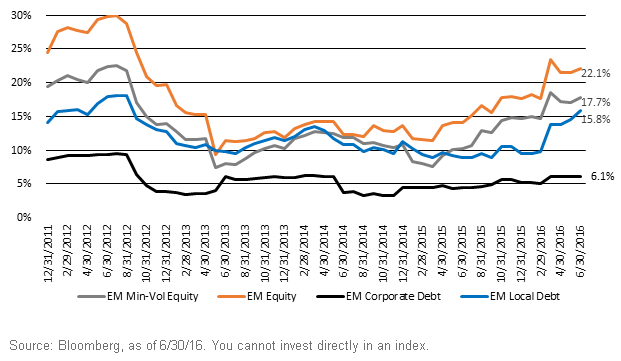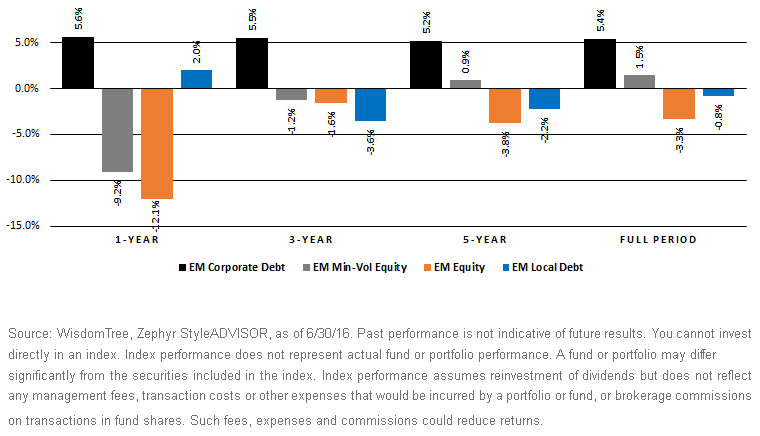Constructing a Lower Volatility Emerging Market Portfolio


 Performance, Correlation and Return Drivers
While investors appear to be buying these strategies for their purported volatility characteristics, what we think they should be focusing on is what those approaches have delivered in total returns. Over virtually every period we examined, min-vol equities were able to reduce volatility by approximately 4% per year compared to EM equities. However, switching to EM fixed income (local debt) netted an additional reduction of 2% compared to EM min-vol. Finally, by avoiding currency risk altogether, investors were able to not only reduce volatility but significantly boost returns as well. In fact, over the entire period, EM corporates outperformed min-vol equities by 3.9% per year with only 32% of the volatility. While correlation against EM equities was lower than other strategies with currency risk, EM corporate bonds averaged a respectable 0.83 over the available data history.
Emerging Markets Annualized Performance
12/31/10-6/30/16
Performance, Correlation and Return Drivers
While investors appear to be buying these strategies for their purported volatility characteristics, what we think they should be focusing on is what those approaches have delivered in total returns. Over virtually every period we examined, min-vol equities were able to reduce volatility by approximately 4% per year compared to EM equities. However, switching to EM fixed income (local debt) netted an additional reduction of 2% compared to EM min-vol. Finally, by avoiding currency risk altogether, investors were able to not only reduce volatility but significantly boost returns as well. In fact, over the entire period, EM corporates outperformed min-vol equities by 3.9% per year with only 32% of the volatility. While correlation against EM equities was lower than other strategies with currency risk, EM corporate bonds averaged a respectable 0.83 over the available data history.
Emerging Markets Annualized Performance
12/31/10-6/30/16
 Ultimately, the drivers of return for EM corporates and EM min-vol equity strategies are different. EM corporate bonds expose investors to U.S. interest rate risk, whereas EM equity performance will be impacted by currency fluctuations. Both will be impacted by the outlook for the financial performance of EM corporations. While EM markets have rebounded sharply so far in 2016, uncertainties about the strength of the global economy remain. In our view, by allocating to EM corporate debt, investors can maintain exposure to emerging markets, significantly reduce volatility and also boost income potential to power returns over market cycles. While the results are of course far from guaranteed, investors looking for a true low-vol approach to emerging markets should consider allocations to EM fixed income.
1Source: Bloomberg, as of 6/29/16.
2As proxied by the MSCI Emerging Markets Index.
3As proxied by the MSCI Emerging Markets Minimum Volatility Index.
4As proxied by the J.P. Morgan GBI-EM Global Diversified Index.
5As proxied by the J.P. Morgan CEMBI Broad Index.
Ultimately, the drivers of return for EM corporates and EM min-vol equity strategies are different. EM corporate bonds expose investors to U.S. interest rate risk, whereas EM equity performance will be impacted by currency fluctuations. Both will be impacted by the outlook for the financial performance of EM corporations. While EM markets have rebounded sharply so far in 2016, uncertainties about the strength of the global economy remain. In our view, by allocating to EM corporate debt, investors can maintain exposure to emerging markets, significantly reduce volatility and also boost income potential to power returns over market cycles. While the results are of course far from guaranteed, investors looking for a true low-vol approach to emerging markets should consider allocations to EM fixed income.
1Source: Bloomberg, as of 6/29/16.
2As proxied by the MSCI Emerging Markets Index.
3As proxied by the MSCI Emerging Markets Minimum Volatility Index.
4As proxied by the J.P. Morgan GBI-EM Global Diversified Index.
5As proxied by the J.P. Morgan CEMBI Broad Index.Important Risks Related to this Article
Fixed income investments are subject to interest rate risk; their value will normally decline as interest rates rise. In addition, when interest rates fall, income may decline. Fixed income investments are also subject to credit risk, the risk that the issuer of a bond will fail to pay interest and principal in a timely manner or that negative perceptions of the issuer’s ability to make such payments will cause the price of that bond to decline.
Investments in emerging, offshore or frontier markets are generally less liquid and less efficient than investments in developed markets and are subject to additional risks, such as risks of adverse governmental regulation and intervention or political developments.
Investments in currency involve additional special risks, such as credit risk and interest rate fluctuations.


